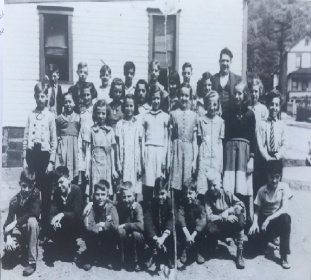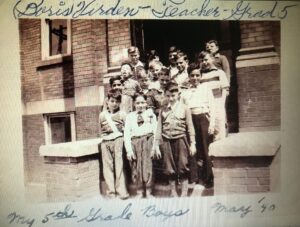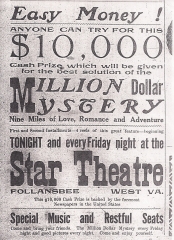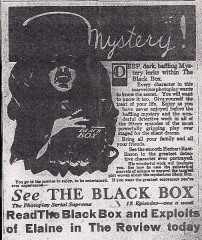A 1931 Ingot student newspaper referred to George Hubbs as “the father of athletics, as he was the coach of all sports during the early period.” According to Hubbs, the earliest sports were football, track, and baseball. The first football game and track events began in 1910, baseball in 1911, and basketball in 1916.
The Steubenville Herald-Star (Oct. 13, 1919) reported that the rival between Toronto and FHS went back to 1912. In 1917, Hubbs was the first to coach Walter “Red” Mahan, who in 1925 became an All American at West Virginia University. With “Red” on the 1917 team, Follansbee tied Wells High School (now Steubenville Big Red), 0-0.
The above 1931 Ingot article also claimed that the 1914 team was the first to officially represent FHS. Earlier teams did exist but were not entirely made up of high school students. According to the1969 “Forge” yearbook, the 1914 team had only 11 players. Their first game was against Steubenville Wells High School’s second team, played at Ferguson Field located north of Mahan Lane. Steubenville won 27-17.
Among the 1914 footballers who played for coach Hubbs were: Russell Cox, Lester Stephens, Clarence Goettling, Gerald Ledger, Lou Diller, Baxter Duncan, Roy Stocks, Emmett Lantz, Harry McGraw, Frank Krager, and Dave Cory.
During the early era, FHS did not have an athletic field or budget for sports. Athletes paid for their own equipment and travel. Only one faculty member was appointed as the team coach, and members from the faculty or community volunteered to assist as “team trainers.” There were no assistant coaches by today’s standards. In the case of coach Hubbs, and Herschel R. Ice, who coached during 1919-1920, both performed double duties as the school principal and athletic coach.
The school depended on local boosters such as confectionaries and pool halls to organize team events. An example of the role boosters played occurred on July 22, 1920. The Steubenville Herald-Star reported: “Candidates for the football team met at Ed Ratcliffe’s poolroom. Plans for the coming season were discussed with those who wished to play on the team. Ed Ratcliffe was assured that the new Pastime Park athletic field would be available to the team.”
Little attention was given to rules regarding player eligibility. Especially before 1916, the FHS male enrollments between 9th and 12th grades barely provided enough players for a full athletic team. In order to have enough athletes, some local boys were recruited who were not in school, but working in the Mill. They were called “ringers,” a common practice at the time.
In 1916, the State Scholastic Sports Association was organized with rules requiring players to be in school on a continuing basis. For the first time, high schools were given more control over their athletics previously organized by outside groups.
Hubbs first official football schedule was established with the 1917 squad. During that year Follansbee played the following opponents (F. Review, Sep. 3, 1931, p.1).
1917 FHS Schedule (3 -2- 3)
- FHS 0-19 Cameron
- FHS 0-27 Wellsville, Ohio
- FHS 13-0 New Cumberland
- FHS 0-0 Steubenville Wells High School JV (now Big Red)
- FHS 18-0 Cadiz
- FHS Mingo – No Score Reported
- FHS 2-17 Wellsburg
- FHS New Cumberland – No Score Reported
- FHS 0-0 Bethany College JVs
- FHS 32-0 Mingo
The 1917 team lineup were: Russell Cox, Lester Stephens, Clerence Goettling, Gerald Ledger, Walter “Red” Mahan, Robert Hurl, J. McBride, P. Miller, T. Evans, Lawrence Claypool, Dawson Riggle, J. Lindell, S. Berardelli, J. Hussar and Ray Stocks. F. Tew assisted Coach Hubbs.
Hubbs quit coaching in late 1917 to take a position at Follansbee Steel. George Hubbs graduated from West Liberty Normal School in 1907. He was a former principal of FHS, and mayor of the city in 1944.
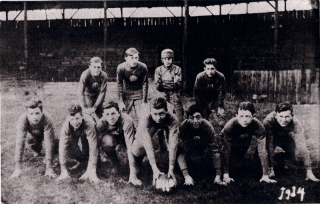
*Photos 1 and 2 taken in front of the Ferguson Field grandstand north of Mahan Lane.
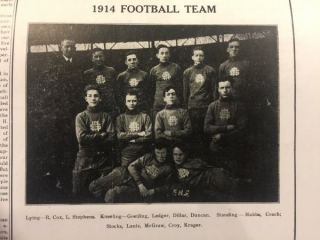
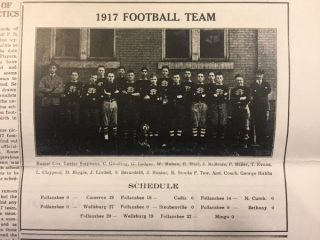
*Photos 3 & 4 in front of old Follansbee High school on Alleghany street. (published schedule in photo incorrect, see 1917 FHS Schedule above.
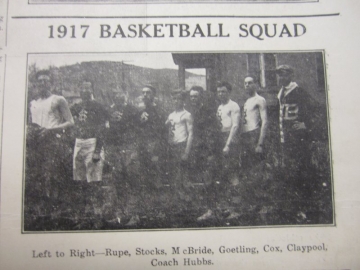
- Steubenville Herald-Star, “Football Meeting,” Jul. 22, 1920. (Meeting at Ed Ratcliffe’s poolroom.)
- Weirton Daily Times, “Follansbee Athletes Honored.” Dec. 12, 1960. (George Hubbs recalled his early coaching years.)


